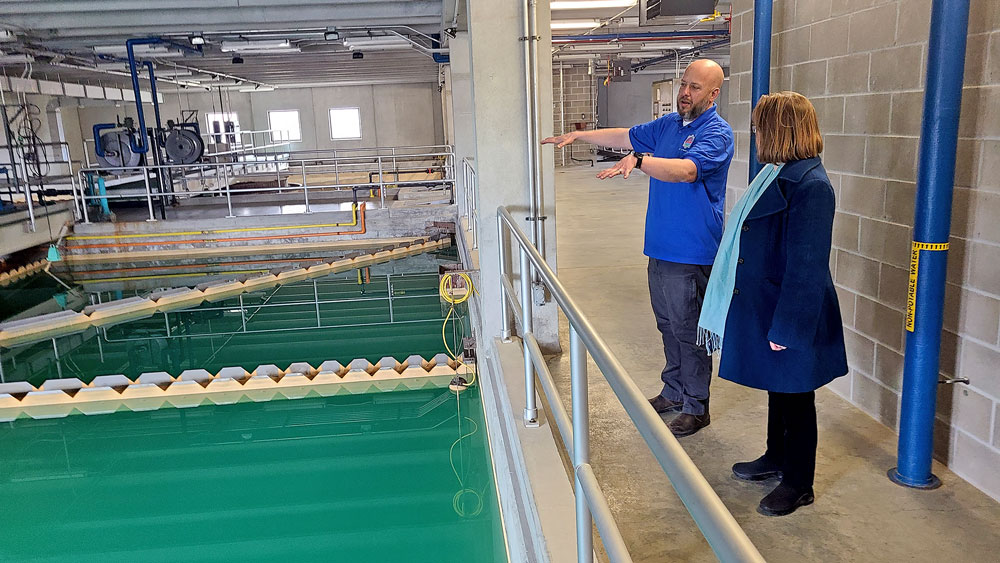Charles City, Floyd County, school district and area development corp. consider shared communications position

By Bob Steenson, bsteenson@charlescitypress.com
Charles City, Floyd County, the local school district and the area development corporation are talking about sharing a community marketing and promotion position, with the idea that it could improve communication to the groups’ local constituents and create a more united message to the outside world.
The position would be a refocusing of one that has been in existence for many years.
Justin DeVore is the director of communications for the Charles City School District, but part of his job has also been director of the local public access network (PAN) that records and presents public meetings and other public events online at charlescitypan.com. He is also the county emergency public information officer.
Part of DeVore’s salary has been paid to the school through the Charles City Broadband Telecommunications Commission, which gets income from cable television franchise fees paid to the city by Mediacom. In fiscal year 2020-21 the commission had paid the school district $43,163. Last fiscal year, which ended June 30, the commission had an agreement to pay the school district $41,100.
Charles City Mayor Dean Andrews told the Floyd County Board of Supervisors at the supervisors’ meeting this week that the fees the city gets from Mediacom have been steadily decreasing, as more and more people give up cable television in favor of streaming or satellite channels. The franchise fee is only paid on cable TV subscriptions, not on the internet access or phone service that Mediacom also provides.
“We felt – not that they weren’t doing a great job of what they did – but we just didn’t feel that they were doing the quantity that justified the $41,000,” Andrews said about the payment to the school district. “So we were having a discussion back and forth as far as what do we want to pay the school for doing some of these things. We talked about decreasing that amount.”
There is currently no agreement between the school district and the Telecommunications Commission or the city in place, so the school district has not been paid anything going into this new fiscal year which began July 1, although DeVore’s group has continued to record public meetings and place them online.
“That $41,000 is approximately half of Justin’s salary and benefits,” Andrews said.
The school district proposed a new distribution of DeVore’s time, working half time for the school district, a quarter of his time for the city, and an eighth of his time (five hours a week, on average) each for the county and the Charles City Area Development Corp. (CCADC).
Andrews said the school district proposed a six-month trial period, with the three other groups contributing half of the annual $41,000 – or $20,500 – to the school district. That would mean for the six-month trial period, the city would pay $10,250 and the county and CCADC would each pay $5,125.
The county already pays $3,000 annually for PAN to record and show Board of Supervisors meetings, and that figure would be included in the amount the county pays, not additional, Andrews said.
DeVore noted that the $3,000 annual figure to record Board of Supervisors meetings had been determined when the supervisors were holding regular meetings only twice a month. Since the beginning of this year the board has held a regular meeting weekly and all those meetings have been recorded for no additional charge.
Andrews said there would be a 28E agreement – a type of agreement in Iowa between public bodies or between public bodies and private groups – that would describe the particulars of the arrangement.
“The city definitely has a need to have a better social media presence,” Andrews said. The city administrator and city clerk put things on the city website when they have time, “but we’re missing a lot of things, I think, social media-wise, website wise.”
He said the CCADC feels the same way, and noted that when the area development corp. received its accreditation from the International Economic Development Council last year, one of the comments that the international group made was that the CCADC doesn’t have much of a social media presence and isn’t on some of the sites that area development corporations typically should be active on.
Dr. Anne Lundquist, school district superintendent, told the supervisors that the arrangement would let the city, school district, county and CCADC have a common message, and show people that the groups are working together toward common goals.
“This is an opportunity as I see it to be more aligned and cohesive on our efforts,” Lundquist said.
DeVore told the supervisors that the job would be about more than the groups’ social media presence, although that would be part of it.
It would include getting the entities on a united calendar, he said. It would also address communications to people who don’t have access to social media or the internet, “because there’s a large percentage of this population that aren’t on that,” he said.
Part of the job in the beginning would be asking, “What do you need?” from each of the partners in the agreement, DeVore said.
Lundquist said an important part of the arrangement would be accountability, and there would be monthly meetings of representatives of each member of the group, as well as time audits, “so you would know on a day-by-day basis how many hours he was spending on efforts for each of the entities involved in the partnership.”
Supervisor Linda Tjaden asked how much viewership the county meetings receive on the PAN website.
DeVore said a typical meeting with nothing controversial being discussed gets about 30 views, but when there is something controversial the supervisors’ meetings are viewed more than any other meetings.
“What I will tell you is, you’re a great traffic driver for us. Thank you. The supervisors do drive a lot of traffic,” he said.
Tjaden said she would be concerned that the arrangement not just cover courthouse activities in Charles City, because they represent the entire county.
Andrews said he would have some concerns about covering events for other cities and school districts in the county, because those entities aren’t contributing to the cost, but if it was an issue or event of countywide interest then it could be covered.
Lundquist said, “I think the nice part about this experiment is that we will ensure that Justin is available to you throughout, and we will ensure that you have accountability for his time. That’s part of the efficiency and the effectiveness of this model. … You won’t have to wait a month to visit with him. If you need to, he’s as close as the phone or the email or a text. What you will get, at the very least, is a monthly accountability of his time, and to ensure that you are getting your (weekly) five hours time.”
Supervisor Roy Schwickerath said, “So we can look and see, are we getting what we paid for?”
Yes, said Lundquist. “And that’s important, because partnerships are really only worthwhile when they’re mutually beneficial.”
DeVore said, “One of the things you’re going to hear from me ad nauseum is, ‘I’m here to serve.’ So, as long as I’ve got time in the week we’ll take care of it.”
The proposal was a discussion item only on the supervisors’ agenda this week, so no action was taken by the board.
Andrews said the school district would like to begin the arrangement Nov. 1, but that’s not a “drop-dead date.” The group agreed to put together a proposed 28E agreement for further discussion.
Also at the meeting this week, the supervisors approved projects that would scan and digitize the large old hardbound records books in the County Recorder’s Office and County Auditor’s Office, both to preserve that information in case of disaster in the courthouse, and to make the information available online.
The board approved a contract with Cott Systems of Columbus, Ohio, to scan books from the Recorder’s Office including 165 loose-leaf books scanned onsite in the courthouse and 191 bound books and volumes offsite at the company’s location in Ohio, including electronic indexing and redacting social security information, for $158,440.
It approved a contract to scan records from the Auditor’s Office including 42 loose-leaf books to be scanned at the courthouse and nine bound volumes to be scanned at the company’s Ohio location, for $62,700.
The total contract price of $221,140 will be paid with county American Rescue Plan Act (ARPA) funds. There is an additional charge of $265 a month for the company to host the electronic records and make the databases searchable and available online.
The hardbound records in the Recorder’s Office cover 1854 to 1989 and the records in the Auditor’s Office range from 1868 to 2005. Once scanned, the records will take up 114 gigabytes of electronic space, Cott estimated.










Social Share